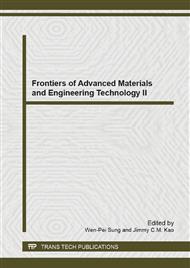p.321
p.325
p.329
p.334
p.338
p.342
p.346
p.352
p.356
Study on Corrosion Behaviors of Epoxy Aluminum Coating Immersed in 3.5%NaCl Solution
Abstract:
Electrochemical corrosion behavior of epoxy aluminum coating immersed in 3.5%NaCl solution was investigated using electrochemical impedance spectroscopy (EIS). SEM was also used to analyze the surface images of coating, and the failure mechanism was discussed as well. The experimental results showed that corrosive species can penetrate into coatings and reach the coating/substrate interface promptly, causing the decrease of electro-resistance and the beginning of electrochemical corrosion at the coatings/metal interface. The coating was compact and continuous at beginning, while the blisters and cavities appeared after corrosion, which were formed osmotic pressure created by corrosion species penetration.
Info:
Periodical:
Pages:
338-341
Citation:
Online since:
April 2014
Authors:
Keywords:
Price:
Сopyright:
© 2014 Trans Tech Publications Ltd. All Rights Reserved
Share:
Citation:


